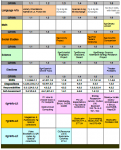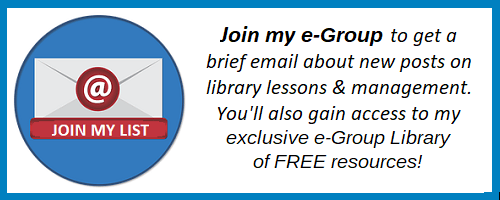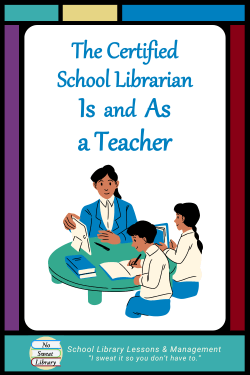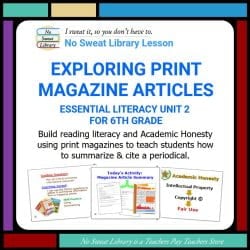 The 5 facets of a certified School Librarian offer a useful organizational paradigm for understanding why this educator is needed in every school. This series of blog posts examines those five roles—experienced teacher, curriculum integration partner, information specialist, program manager, and education leader—to elaborate on each one and to offer how we can best fulfill each role.
The 5 facets of a certified School Librarian offer a useful organizational paradigm for understanding why this educator is needed in every school. This series of blog posts examines those five roles—experienced teacher, curriculum integration partner, information specialist, program manager, and education leader—to elaborate on each one and to offer how we can best fulfill each role.
The first post of the series examined that most important role of experienced teacher. In this next post of the series, we explore what I consider the second most essential role: the certified School Librarian is and as a curriculum integration partner.
THE CERTIFIED SCHOOL LIBRARIAN IS A CURRICULUM PARTNER
Our teaching certificate and years of experience help us successfully work with teachers, but there’s more! The certified School Librarian knows every subject’s curriculum and their national and state curriculum standards. We don’t have the depth of knowledge that teachers do, but we know the breadth of all subject curricula through all grade levels so we perceive when to approach teachers for a collaborative opportunity.
The certified School Librarian can fully incorporate library resources, services, and instruction with classroom activities because we glean what students are studying that could bring them to the library, and then we determine which library skills students need to know in order to do what the teacher expects them to accomplish.
 With this background knowledge, the certified School Librarian can plan Library Lessons:
With this background knowledge, the certified School Librarian can plan Library Lessons:
- that are based on each subject’s curricular Standards and educational best practices.
- that are scaffolded to build knowledge and skills.
- that use high-quality resources in print and digital forms.
- that seamlessly introduce new media and technologies.
- that have meaningful activities to practice learning.
- that will increase student achievement.
While we can’t impose lessons on teachers, we show them how we can enhance existing classroom activities with what we deem students need, and we guide teachers toward infusing their projects with more student-centered inquiry. We work with them to teach the processes of learning while they teach the content, and we provide the best available resources so their content area teaching results in successful learning for all students.
| Other blog posts that address the certified School Librarian’s role as a curriculum integration partner. |
| 5 Essential Literacies for Students: Part 2 Content Area Literacy – The certified School Librarian integrates reading, writing, thinking, and communication skills specific to each discipline’s vocabulary, concepts, and methods. |
| To Teach Critical Thinking & Inquiry Learning, Entrust Your School Librarian – The certified School Librarian is an authority on critical thinking, because our Information Literacy curriculum is all about analyzing, evaluating, inferencing, synthesizing, and communicating complex information in multiple formats. |
| School Librarians: Show Teachers Their National Standards Require Student Research – At least 46 National Standards for middle school subjects require or align with students doing research assignments. |
THE CERTIFIED SCHOOL LIBRARIAN AS A CURRICULUM PARTNER
Ideally, the certified School Librarian and the classroom teacher are a team that works together to contribute to student achievement, yet seemingly this partnership is the hardest one for us to actualize. One obstacle is on us, and the second obstacle is with teachers. I’ve found solutions to both of these obstacles.
THE LIBRARY LESSON CURRICULUM MATRIX
Being a curriculum guru sounds easy, but it’s hard to know which library lessons to teach and when and to whom. Since most of us come from a single-subject teaching experience, we need spend time examining every other subject area curriculum to discern what students are learning in their classes that might benefit from a Library Lesson that builds on that classroom experience.
To keep track of these possibilities, I created a visual organizer—a set of spreadsheets—that I call my “Library Lesson Curriculum Matrix.” This unique tool also helps me develop continuity for Information Literacy skills among sporadic lessons scattered between a variety of subjects and across grade levels.
At the start of a grading period I check my Matrix to see which teachers have upcoming lesson opportunities. Then, for a few minutes during their conference/planning periods, I go to their classrooms with my Library Lesson Curriculum Matrix to schedule a library visit.
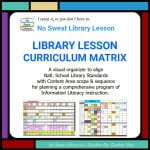 |
The School Library Lesson Curriculum Matrix is available through No Sweat Library, my TeachersPayTeachers store. |
THE SCHOOL LIBRARY LESSON PLANNER
Teachers who understand the benefits of collaborating with the School Librarian are in the minority, so how to convince them to accept a lesson and bring classes to the library is the second obstacle. We must show them that our library lesson is tied to their subject standards, is relevant to what their students are studying in the classroom, and has students producing something relevant and meaningful.
 When visiting teachers for prospective lessons, I bring the Library Lesson Plan I’ve generated for their proposed library visit or project. Yes, Library Lesson Plan. If we want teachers to regard us as a teaching professional, we need to show them a lesson plan that fully incorporates what they are doing in their classroom.
When visiting teachers for prospective lessons, I bring the Library Lesson Plan I’ve generated for their proposed library visit or project. Yes, Library Lesson Plan. If we want teachers to regard us as a teaching professional, we need to show them a lesson plan that fully incorporates what they are doing in their classroom.
The visual planner makes teachers more willing to collaborate with me … and it’s even more compelling if I create a sample of the library activity (or screen-shot of technology) so they can see what students will be doing. That extra step nearly always clinches the teachers accepting a library lesson visit.
The School Library Lesson Planner is a FREE download from my FREE Librarian Resources page.
TEACHING EXAMPLES & INSPIRATION FOR YOU
Here are a few ways to implement classroom learning into library visits:
- What’s a Library Lesson Curriculum Matrix & How Do I Use It?
- How to Build a High Quality, Standards-Based School Library Lesson
- How To Propose School Library Lessons to Teachers
- School Librarians Can Use Professional Development to Create “Essential” Lessons
- How a School Librarian Responds to Teacher Requests & Lesson Ideas
Here are successful collaboration lessons that are available in No Sweat Library, my Teachers Pay Teachers store.
|
Library Lessons Bundle: Doing Dewey Decimals with Math Math teachers were thrilled when I approached them to visit the library for a review of decimals at the start of their unit! The collaboration resulted in these 2 lessons that are much more fun—and revealing—than a pre-test. 6g has a simple book locating activity for recognizing decimal sequencing. 7g adds & subtracts decimals then locates books that match the answer. |
 |
|
Comparing Multicultural Cinderella Fairy Tales to Support 6g ELA This is the first lesson in a completely collaborative unit that is also co-taught by ELA teacher and School Librarian. Students review plot elements through an interspersed read-aloud of the original Perrault Cinderella story. For their activity student pairs read an alternate cultural rendition of the story, and compare/contrast cultural elements (studied in Social Studies World Cultures) using a double-bubble graphic organizer. |
 |
|
Library Orientation Lesson – Viewing Video Book Trailers with 8th grade ELA This collaboration with 8g ELA is both a library orientation and an introduction to students’ first ELA project. The lesson has students use their own Smartphones to scan QR codes linked to video book trailers, which inspires them for creating their own. |
 |
The certified School Librarian‘s second most compelling endeavor needs to be as a curriculum integration partner with the teachers in our building. Yet, we do have other important roles to perform. Read the next blog post in this series, which looks at the certified School Librarian Is and As an Information Specialist.

